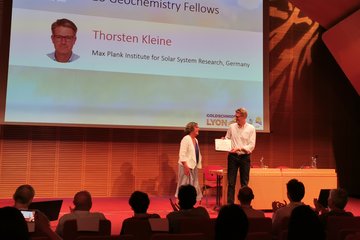Alle Typen
101.
Zeitschriftenartikel
Bursty energetic electrons confined in flux ropes in the cusp region. Planetary and Space Science 51, S. 821 - 830 (2003)
102.
Zeitschriftenartikel
A telescopic and microscopic view of a magnetospheric substorm on 31 March 2001. Geophysical Research Letters 29 (18), 1862 (2002)
103.
Zeitschriftenartikel
Timing of magnetic reconnection initiation during a global magnetospheric substorm onset. Geophysical Research Letters 29 (24), 2190 (2002)
104.
Zeitschriftenartikel
First multispacecraft ion measurements in and near the Earth's magnetosphere with the identical Cluster ion spectrometry (CIS) experiment. Annales Geophysicae 19 (10/12), S. 1303 - 1354 (2001)
105.
Zeitschriftenartikel
First results from the RAPID imaging energetic particle spectrometer on board Cluster. Annales Geophysicae 19 (10/12), S. 1355 - 1366 (2001)
106.
Zeitschriftenartikel
Particle acceleration at comet related shock surfaces. Astrophysics and Space Science 264, S. 545 - 566 (1999)
107.
Zeitschriftenartikel
Observation of interplanetary particles in a corotating interaction region and of energetic water group ions from Grigg-Skjellerup. Planetary and Space Science 45, S. 1105 - 1117 (1997)
108.
Zeitschriftenartikel
Characteristic boundary transitions in energetic particle data (60-260 keV) recorded at comets P/Grigg-Skjellerup and P/Halley by the EPONA instrument on Giotto. Planetary and Space Science 45, S. 1119 - 1142 (1997)
109.
Zeitschriftenartikel
RAPID: The Imaging Energetic Particle Spectrometer on Cluster. Space Science Reviews 79, S. 399 - 473 (1997)
110.
Zeitschriftenartikel
The distribution of reconnection geometry in flux transfer events using energetic ion, plasma, and magnetic data. Journal Geophysical Research 89, S. 3843 - 3854 (1984)
111.
Zeitschriftenartikel
Remote sensing of a flux transfer event with energetic particles. Journal Geophysical Research 88, S. 3971 - 3980 (1983)
112.
Zeitschriftenartikel
Motion of flux transfer events on 10 November 1977 determined by energetic particles on ISEE 2. J. Geophys. 52, S. 199 - 202 (1983)
113.
Zeitschriftenartikel
Remote sensing of energetic particle boundaries. Geophysical Research Letters 9, S. 1329 - 13329 (1982)
114.
Zeitschriftenartikel
Trapped electron distributions on open magnetic field lines. Journal Geophysical Research 87, S. 6081 - 6088 (1982)
115.
Zeitschriftenartikel
Observation of a flux transfer event on the earthward side of the magnetopause. Planetary and Space Science 30, S. 331 - 337 (1982)
116.
Zeitschriftenartikel
Observations of field-aligned energetic electron and ion distributions near the magnetopause at geosynchronous orbit. Journal Geophysical Research 87, S. 10413 - 10419 (1982)
117.
Zeitschriftenartikel
Field line topology determined by energetic particles during a possible magnetopause reconnection event. Journal Geophysical Research 87, S. 6073 - 6080 (1982)
118.
Zeitschriftenartikel
Ion jetting at the plasma sheet boundary: simultaneous observations of incident and reflected particles. Geophysical Research Letters 8, S. 987 - 990 (1981)
119.
Zeitschriftenartikel
Plasma sheet motions inferred from medium-energy ion measurements. Journal Geophysical Research 86, S. 7543 - 7556 (1981)
120.
Zeitschriftenartikel
Particle signature of magnetic flux transfer events at the magnetopause. Journal Geophysical Research 86, S. 1628 - 1632 (1981)











